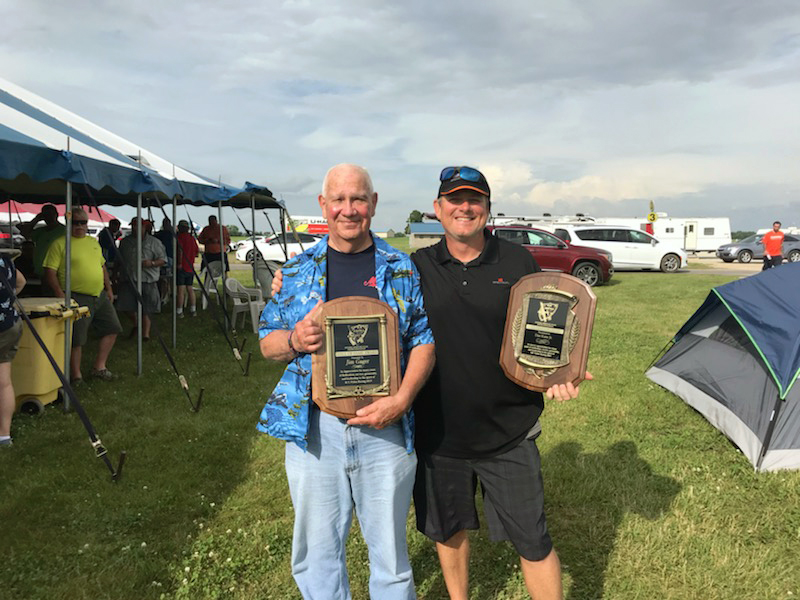
Congratulations to James Gager (left) and Danny Kane (right) who were both inducted into the National Miniature Pylon Racing Association (NMPRA) Hall of Fame during the NMPRA Nats banquet Monday, July 15, 2019.
James, who has spent much of his life very active in model aviation wanted to give back to the hobby after receiving the award. He decided to make a very generous donation of $2,000 to the AMA Foundation and $500 to the NMPRA.
The AMA Foundation asked James for his story on how he got started in the hobby, and the following is what he had to say:
I’ve been asked to reflect on my participation in modeling and Quarter Midget racing in particular, so here are my recollections, obviously, so things may be remembered differently by others.
My first modeling experience was at five years old and I still have the scar from it. My older brother who was twelve at the time was into building gas powered free flights and his work area and tools were completely off limits to me. One day he forgot to lock the little room that he used as a shop and while he was out I decided to build a little hand glider. Inexperience with using a very sharp X-acto knife led to a very deep cut to my left thumb and profuse bleeding. There was no way to hide it, so I had to show my mom, and then off to the doctor we went to get stitches. After a period of time, maybe months or a year of pestering my brother to show me how to work with modeling tools, he began to teach me how to safely build models.
The next recollection of a highlight occurred when I was ten. One of the local grocery stores in the Chicago suburb that I lived in held a model building contest. There were several classes and I fit into the 8-12-year-old group. The store provided the model kit, most likely a Comet kit, of a high wing monoplane built with stick and tissue fashion. Other than using the kit and no adult help allowed, there were no rules. So, I built the kit and instead of using tissue as covering, I covered it with a 1/32” balsa sheet, and I finished it with automotive lacquer that I borrowed from my brother’s stash/ I don’t recall how the winners were picked, but I won my class. Not without controversy though, as some adults thought I cheated by using balsa sheet instead of covering. None the less, I was awarded the first prize for my class, a .35 powered U Control Kit, which I believe was called the Continental. Since I was ten and my only source of income was picking up discarded pop bottles along the highways, there was no way I could afford to build it, buy an engine or fuel for it, not to mention the support equipment to be able to fly it.
I walked down to the local hobby shop and managed to convince them to trade me a ready-to-fly Cox Kit for the Continental. So started my U-Control flying. It’s a good thing that Cox plane was plastic, as it took a lot of abuse while I learned to fly. I continued to build U-Control until my mid-teens when I noticed other things were holding my interest more and more and I gave up modeling.
A number of years later, now married, I was on my way home from work when I noticed my younger brother and his friend in that same grocery parking lot attempting to fly a Cox model plane. So, I stopped to help and that night the modeling bug bit again. I went to the hobby shop, bought a U-Control kit and started building it that night on the kitchen table. I flew U-Control for a number of years at the Chicago U-Liners field at the Kickapoo Forest Preserve field in Harvey. This would have been the mid-sixties at which time U-Control was falling from favor for R/C models.
At the south-side of the forest preserve there was a group of few R/Cers, I watched them over a period of time and took the plunge. I bought a used Orbit radio (big mistake, there was a reason it was used) the next mistake was the airplane choice, I bought a popular bi-plane kit, not a good choice to learn on. After getting it built and setup I went out to the field to get some help in flying it. Nobody else showed up that day. Same the the next time I went out. After hanging around the field awhile (bored) I thought I’d just fire it up, tune the engine and taxi around a bit to check things out. Everything seemed fine so I gave it full throttle and I took it off. It was magnificent! A beautiful takeoff, airplane climbing at a steep angle, throttle back to level off and BOOM, into a stall and then a spin. I had no thought as to how to get out of the spin and so watched it smash into the ground. A total wreck.
Shortly after that I moved to Kankakee, Illinois, and there were no active R/C flyers that I could find. I’d built a new trainer plane, talked the local park folks into allowing me to fly out of and unused portion of the park and manager to teach myself to fly. From then on it was flying what were commonly called pattern planes and I participated in some competition flying.
In 1969 I moved my family to Fort Wayne, Indiana, and shortly after discovered the Fort Wayne Flying Circuits Model Airplane Club. Sometime in the early 70’s, QM .15 racing started across the nation and my interest in racing perked up. The first plane I built was a Rivets from what I believe were RCModeler magazine plans. I attended my first race in Lafayette, IN and from then on that was my all-consuming passion.
Unfortunately, my flying skills weren’t quite up to the performance level of the airplanes and I went through a lot of airplanes. By this time there were a number of fiberglass and foam airplanes on the market, but the quality and cost were onerous, so I decided to make my own kit.
With the help of my best friend and flying buddy, Allen Booth, we developed a .15 size model of the scale Estrellita. Allen carved the first fuselage plug and helped me make the molds. We then learned how to cut foam for the wing cores and with that it became the first GAS (Gager Aircraft Sales) model kit. The airplane proved to be a success and soon I was being asked to sell the kit, which I began to do. The Estrellita was the first on nine different .15 QM kits I produced over the years. I also produced a couple of Formula 1 kits and some Sport Scale Kits.
By this time I had become a Contest Director and through the Flying Circuits we were having annual QM and F1 contests at our Fort Wayne field. In the mid-70’s I believe we had the first money race ($1,000) split among QM and F1 winners. The money races continued for several years.
At some later point, probably the late 70’s or early 80’s, QM .15 race attendance was declining across the country. There were numerous reasons proffered for the decline, but a part of the decline was that there was only one viable engine and with the straight through exhaust, noise complaints were starting to limit airfields available to racing and the available airfields were also in decline.
The contest board, (of which I was a member) at the request of the majority of QM racers and race sponsors, looked into making changes in the rules to try to reinvigorate the event. It was decided to look into up-sizing the engine and airplane specifications to allow the use of the then Q-500 engine. There were a couple of different motors available to Q-500 and they all had tuned mufflers to keep noise down.
I built a test airplane to the newly up-sized proposed specifications and debuted it at that years Rough River QM .15 Championship race. That size plane and engine combo was squarely in the speed range of the Q-500 and the majority of contest attendees thought the event should feature faster airplanes, so the airplane specifications were downsized slightly. The thinking being, Q-500 would be the starting event for newcomers to racing and they could then progress to the faster Q-40 event and then progress to the premier F1 event.
Once the new rules were passed, I started producing 3 different QM 40 kits.
One of the highlights of my kit business took place at the prestigious Silver Cup race sponsored by the Toledo Weak Signals. This race was always held at the end of the Mid-west racing season and was always well attended by QM .15 racers from around the country. At this particular race there were 51 entries and 29 of them were from kits I had produced.
Along with participating in racing, I also wrote the Pylon column for Model Builder Magazine for about eight years. I also wrote several columns on pylon racing for Model Airplane News.
For several years I did some consulting work for the then Top Flight Models Company in both kit development and advertising.
I continued modeling until about 2005 when I gave in to my long-buried desire to work on old cars and trucks. With time for only one all-consuming hobby, I gave up model airplanes.
One thing that continually surprises me is the parallels in modeling and old car/truck restoration, and actually, in life itself.
The AMA and AMA Foundation thank both James and Danny for their years of great service to the hobby. James has earmarked his contributions to purchase 5 bricks in the AMA Walk of Fame for himself, his son’s, and his late wife, with the additional funds earmarked for AMA’s educational programming.
We would also like to thank the National Miniature Pylon Racing Association for it’s continued support of the AMA Foundation with donations to the Cliff and Nancy Telford Memorial Scholarship.
See more from the 2019 RC Pylon Nats in our Flickr gallery!




















